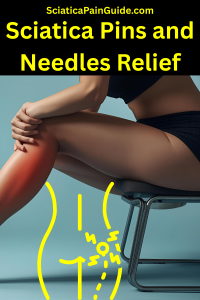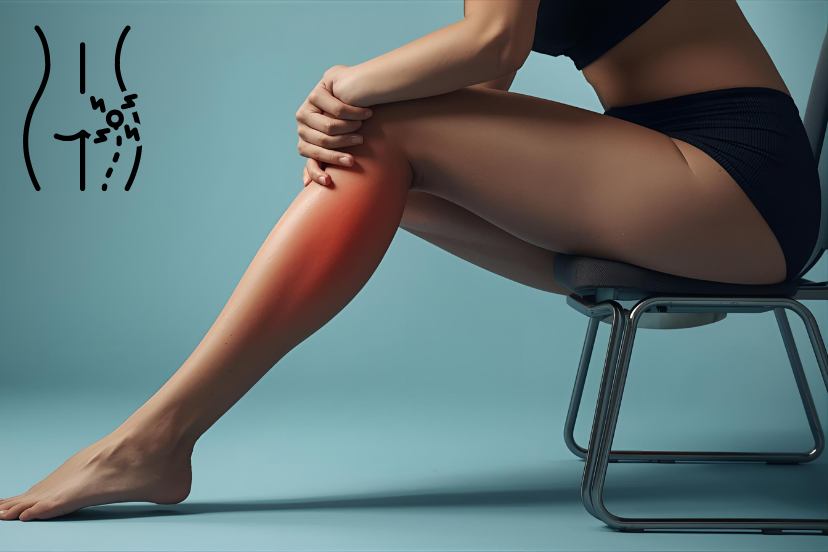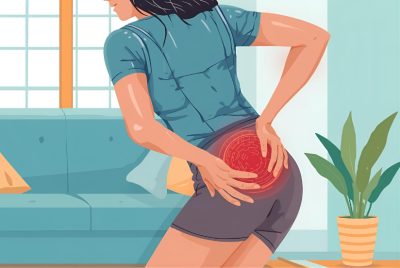Sciatica Pins and Needles Relief: Causes, Treatments, and Prevention
Why That Tingling Feeling Matters
If you’ve ever felt a pins and needles sensation running down your leg, you know how disruptive sciatica can be. Beyond sharp lower back pain and leg weakness, many people experience constant tingling that makes it difficult to sit, walk, or even sleep. This numbness and tingling—often described as “electric shocks” or “foot asleep” sensations—comes from pressure or irritation along the sciatic nerve. The good news? Sciatica pins and needles relief is possible with the right combination of home remedies, medical treatments, and lifestyle changes.
Let’s dive into what causes this sensation, how to manage it, and what steps can prevent flare-ups in the future.
What Causes Pins and Needles With Sciatica?
The “pins and needles” feeling occurs when the sciatic nerve—the longest nerve in your body—becomes compressed or irritated. Common causes include:
-
Herniated Disc Sciatica: A bulging disc presses on the sciatic nerve roots.
-
Spinal Stenosis: Narrowing of the spinal canal reduces nerve space.
-
Piriformis Syndrome Sciatica: A tight piriformis muscle in the buttocks irritates the nerve.
-
Sciatic Nerve Compression: From poor posture, prolonged sitting, or carrying items in back pockets (wallet sciatica).
-
Chronic Sciatica: Long-term inflammation and pressure on the nerve cause recurring tingling.
Symptoms That Accompany Pins and Needles
Sciatica tingling is rarely the only symptom. Many people also experience:
-
Lower back pain sciatica that radiates into the buttock or leg
-
Numbness in the calf or foot
-
Muscle weakness in the leg
-
Sciatica pain running down the leg when sitting or standing too long
-
Burning or electric-shock sensations in the thigh or foot
At-Home Remedies for Sciatica Pins and Needles Relief
You don’t always need to rush to the doctor—many people find relief with simple home strategies.
Heat or Ice for Sciatica
-
Ice packs reduce inflammation during acute flare-ups.
-
Heat pads relax tight muscles during chronic sciatica.
Wallet Sciatica Relief at Home
-
Never sit with a wallet in your back pocket.
-
Switch to front-pocket carrying or use slim wallets to reduce piriformis irritation.
Natural Remedies for Sciatica
-
Anti-inflammatory foods: salmon, berries, turmeric, and ginger.
-
Epsom salt baths to relax tense muscles.
-
Magnesium supplements (consult your doctor first).
Sciatica Pain Treatment at Home
-
Change positions every 30–45 minutes.
-
Gentle walking with sciatica pain to improve circulation.
-
Use lumbar cushions when sitting with sciatica for long periods.
Best Sciatica Exercises for Pins and Needles Relief
Movement helps relieve compression and improve blood flow to the sciatic nerve. Try these safe options:
-
Piriformis Stretch – Lie on your back, cross one leg over the other, and pull your knee toward your chest.
-
Seated Hamstring Stretch – Sit with one leg extended, reach toward your toes, and hold.
-
Knee-to-Chest Stretch – Loosens the lower back and relieves pressure.
-
Cat-Cow Stretch – Promotes spinal mobility and flexibility.
-
Pelvic Tilts – Strengthen your core and improve posture.
👉 Consistency matters: doing sciatica stretches at home daily can gradually reduce pins and needles.
Medical Treatments for Sciatica Tingling
If home remedies aren’t enough, medical options may be necessary:
-
Sciatica Physical Therapy: Builds strength, flexibility, and posture awareness.
-
Chiropractic Adjustments: Can reduce sciatic nerve compression.
-
Epidural Steroid Injections: Provide temporary inflammation relief.
-
Medications: NSAIDs, muscle relaxers, or nerve pain medications like gabapentin.
-
Surgery: Reserved for severe cases of herniated disc sciatica or spinal stenosis.
Lifestyle Changes to Prevent Pins and Needles
Relief from tingling is important, but preventing future flare-ups is the real goal. By making simple but consistent lifestyle changes, you can lower the chances of recurring sciatica symptoms and keep your daily life more comfortable.
1. Improve Sleep Habits
-
Best Sleeping Position for Sciatica: Side sleeping with a pillow between your knees keeps the spine aligned, while back sleeping with a pillow under your knees reduces lower back strain.
-
Mattress Choice: A medium-firm mattress supports your back while preventing sagging. U.S. brands like Tempur-Pedic and Saatva are popular with people who have back pain.
-
Pillow Support: Choose ergonomic pillows to keep your neck and spine aligned.
2. Stay Physically Active
-
Low-Impact Cardio: Swimming, walking, and cycling improve circulation without straining your back.
-
Stretching Routine: Daily sciatica stretches at home (hamstring, piriformis, pelvic tilts) help release pressure on the sciatic nerve.
-
Strength Training: Building core and glute strength provides long-term stability and prevents flare-ups.
3. Ergonomics at Work and Home
-
Workstation Setup: Use an ergonomic chair with lumbar support. Keep your monitor at eye level and feet flat on the floor.
-
Frequent Breaks: Stand, stretch, or walk every 30 minutes to avoid prolonged pressure on the sciatic nerve.
-
Anti-Fatigue Mats: If your job requires standing, these mats reduce lower back and leg strain.
4. Maintain a Healthy Weight
Extra weight—especially around the midsection—adds stress to the lower spine. Even modest weight loss (5–10%) can significantly reduce sciatic nerve compression.
-
Focus on a balanced diet with lean proteins, vegetables, fruits, and whole grains.
-
Limit processed foods and excess sugar that may increase inflammation.
5. Supportive Footwear
-
Choose shoes with good arch support and cushioning.
-
Avoid high heels, flip-flops, and unsupportive flats.
-
Consider custom orthotics if you have flat feet or posture imbalances.
6. Safe Movement and Lifting Techniques
-
Lift Properly: Bend at the knees, keep the object close to your body, and avoid twisting while carrying weight.
-
Daily Posture Check: Avoid slouching when sitting or leaning on one hip when standing.
-
Light Core Engagement: Keep your abdominal muscles gently engaged when walking or standing to support your spine.
7. Stress and Tension Management
Stress can lead to tight muscles, especially in the back and hips. Managing stress helps prevent muscle tension that triggers sciatica.
-
Try meditation or mindfulness apps (like Calm or Headspace).
-
Practice deep breathing before bed.
-
Consider gentle yoga or Pilates for flexibility and stress relief.
8. Hydration and Nutrition
-
Drink plenty of water (8–10 cups daily) to keep spinal discs hydrated and flexible.
-
Add anti-inflammatory foods like salmon, turmeric, olive oil, and leafy greens to your diet.
-
Reduce alcohol and caffeine, which can dehydrate the body and worsen stiffness.
👉 By consistently applying these lifestyle changes to prevent pins and needles, you can minimize flare-ups and improve your quality of life. These habits don’t just reduce tingling—they strengthen your back, support your spine, and keep your nervous system healthier long term.
✅ Sciatica Prevention Cheat Sheet: Stop Pins & Needles
Sleep Habits
-
Sleep on your side with a pillow between your knees
-
Or sleep on your back with a pillow under your knees
-
Use a medium-firm mattress and ergonomic pillow
Stay Active
-
Walk, swim, or cycle 20–30 minutes daily
-
Do daily sciatica stretches at home (hamstrings, piriformis, pelvic tilts)
-
Strengthen your core and glutes
Ergonomics
-
Sit in a chair with lumbar support
-
Keep screens at eye level & feet flat
-
Take a stretch break every 30 minutes
-
Use anti-fatigue mats if standing for work
Weight & Nutrition
-
Maintain a healthy weight (lose 5–10% if overweight)
-
Eat anti-inflammatory foods (salmon, berries, leafy greens)
-
Limit sugar, alcohol, and processed foods
-
Drink 8–10 cups of water daily
Footwear & Movement
-
Wear supportive shoes with cushioning
-
Avoid high heels, flip-flops, and unsupportive flats
-
Use orthotics if needed
-
Bend at the knees when lifting — never at the waist
Stress Management
-
Try meditation or deep breathing before bed
-
Use mindfulness apps (Calm, Headspace)
-
Practice yoga or Pilates for relaxation
👉 Keep this checklist handy and check off habits daily — small, consistent actions can make a big difference in reducing sciatica pins and needles flare-ups.
Real-Life Coping Strategies
People in the U.S. often combine multiple approaches:
-
Using anti-fatigue mats at standing jobs
-
Alternating between standing desks and seated breaks
-
Practicing daily stretching routines from sciatica physical therapy
-
Applying heat or ice for sciatica after long workdays
-
Exploring chronic wallet sciatica treatment by changing habits and posture
FAQs About Sciatica Pins and Needles Relief
1. What does pins and needles from sciatica feel like?
It feels like tingling, numbness, or “electric shocks” traveling from the lower back into the leg or foot. The intensity varies depending on nerve compression.
2. How do you stop pins and needles from sciatica fast?
Applying heat or ice, gentle stretching, and changing positions often provide immediate relief. For persistent symptoms, physical therapy or medication may be necessary.
3. Can sitting make sciatica pins and needles worse?
Yes. Prolonged sitting compresses the sciatic nerve, especially with poor posture or when sitting on a wallet. Stand, stretch, or walk every 30 minutes.
4. What are the best sciatica exercises for tingling relief?
Piriformis stretches, hamstring stretches, pelvic tilts, and cat-cow movements help ease pressure on the sciatic nerve and reduce tingling sensations.
5. Do I need surgery if I have constant sciatica tingling?
Not usually. Most cases improve with conservative treatments like physical therapy, exercise, and medication. Surgery is only needed for severe or chronic nerve compression.
6. Can sciatica pins and needles go away on their own?
Yes, mild flare-ups often improve within a few weeks. However, recurring or worsening symptoms may require medical evaluation and treatment.
7. What causes sciatica flare-ups that lead to pins and needles?
Common triggers include poor posture, heavy lifting, prolonged sitting, excess weight, or tight muscles like the piriformis pressing on the sciatic nerve.
Conclusion: Take Back Control From Tingling Sciatica
Living with constant tingling or numbness from sciatica can feel overwhelming—but you don’t have to suffer in silence. By combining sciatica pins and needles relief strategies like stretching, posture correction, lifestyle changes, and medical support when necessary, you can manage symptoms and prevent flare-ups.
Consistency is the key: small daily habits add up to big results in restoring comfort, mobility, and peace of mind.
Disclaimer
This article is for informational purposes only and does not replace professional medical advice. Always consult a licensed healthcare provider before starting new exercises, treatments, or medications for sciatica.
👉 Explore more:
- Tingling in Foot Sciatica Home Remedies
- 10 Proven Home Remedies for Sciatica Pain Relief Without Medication
- What Is the Best Pain Relief for Severe Sciatica





